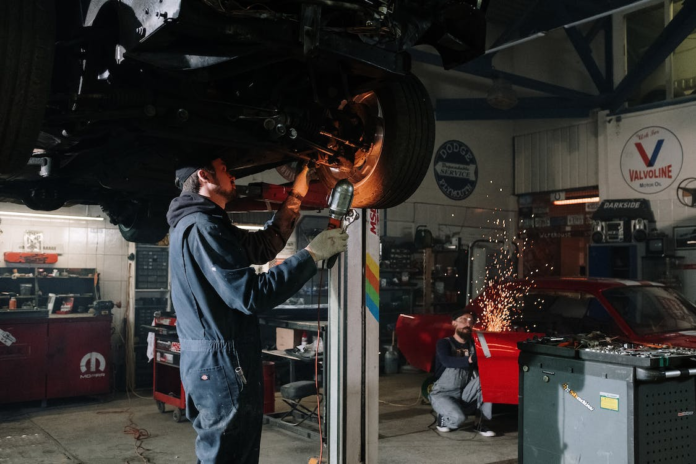A. Definition of Coil-Over Suspension
The coil-over suspension consists of an assembly containing a coil spring to cushion the car from bumps and shocks, along with a shock absorber that controls the amount of rebound after each impact. The entire assembly is mounted on top of the lower control arm so that it can be adjusted for ride height, stiffness and dampening. This allows for greater tuning potential than traditional strut or MacPherson-style suspensions.
B. Benefits of Coil-Over Suspension
The primary benefit offered by coil-over suspension systems is improved handling characteristics due to increased adjustability over traditional strut or MacPherson-style suspensions. Adjustments to ride height allow drivers to fine-tune their vehicles’ centre gravity for improved cornering ability at higher speeds while also providing a more aggressive look overall when lowered appropriately. Furthermore, adjustments to stiffness allow drivers to customize the amount of body roll experienced during cornering manoeuvres while still maintaining a comfortable driving experience at normal speed limits.
Types of Coil-Over Suspension
When it comes to vehicle suspension, there are many different types of shock absorbers available. One type that is common in many vehicles today is the coil-over suspension. Coil-over suspension is an adjustable system which allows for a great degree of customization and control over the handling and rides quality of a vehicle.
The two most popular types of coil-over shock absorbers are twin tube and monotube shocks. Both offer unique benefits, so let’s take a closer look at each type to help you decide which one is best for your driving needs.
- Twin Tube Shock Absorbers: Twin tube shock absorbers are the more traditional option when it comes to coil-over suspensions. They feature an inner tube filled with oil that works as the primary dampening agent, while an outer tube contains compressed gas which helps reduce noise levels and provides additional support when needed. The benefit of twin tubes over monotubes is their increased durability due to having two separate chambers filled with oil – meaning they can last longer than monotube shocks in certain conditions such as off-road driving or racing applications where they may be subject to greater stresses than normal on roads or highways.
Adjustability of Coil-Overs
Coil-overs are one of the most versatile and adjustable suspension components available to automotive enthusiasts. They offer an unparalleled level of control over the ride characteristics of a vehicle, allowing drivers to fine-tune their suspension setup for different driving conditions or preferences. The two primary aspects of adjustability that coil-overs offer is spring rates and ride height adjustment.
Adjusting spring rates is one of the most important aspects when it comes to tuning a vehicle’s suspension. Spring rates determine how much resistance a spring has against being compressed or expanded, which then affects how stiff or soft a vehicle’s ride is. Stiffer spring rates provide less body roll during cornering, while softer springs allow for more absorption over bumps in the road but can lead to more body roll during turns. Coil-over systems allow drivers to easily adjust their spring rate by simply rotating an adjusting knob on top of each shock absorber, making it easy and convenient to fine-tune your suspension on the fly without having to change out springs altogether.
Ride height can also be adjusted with coil-overs by simply turning an adjusting knob located at the bottom of each shock absorber or strut assembly.
Installation Process for Coil-Overs
Installing coil-overs is an important part of making sure your vehicle handles and performs to its fullest potential. Coil-overs are a type of suspension system that uses coil springs around the shock absorbers, allowing for greater adjustability and improved performance. Installing them correctly is essential to ensuring that your vehicle handles properly and safely.
The installation process for coil-overs can vary depending on the type of vehicle you have, but most installations require specialized tools such as spring compressors, shock wrenches, and other speciality tools. Before beginning the installation process, you should read through all of the instructions that came with your kit or consult a professional if you need assistance or advice.
Once you have all of the necessary tools in hand, it’s time to begin installing the coil-over system onto your vehicle. First, park your car on level ground so that it is easier to work with throughout the entire installation process. Next, loosen any bolts or nuts that are holding in place any existing suspension components such as shocks and struts so they can be removed easily later on in the process. After this step has been completed remove both wheels from one side or corner of your car depending on what kind of kit you purchased (front only or four corners).
Conclusion
Coilovers offer a great way to get improved handling performance from your vehicle without sacrificing ride quality. They are adjustable, allowing you to easily fine-tune your suspension for various driving conditions. They are relatively easy to install and maintain, and they can offer significant improvements in cornering, traction, and stability. With their many advantages, it is no surprise that coil overs have become such a popular choice amongst car enthusiasts everywhere.











